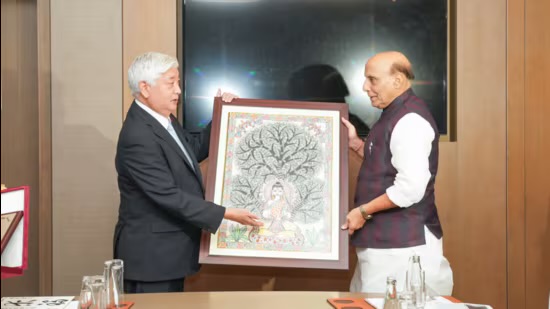India-Japan Defense Talks
India and Japan have reaffirmed their commitment to strengthening defense ties. The two nations discussed enhancing cooperation in military supply, joint exercises, and defense manufacturing. Indian Defense Minister Rajnath Singh met his Japanese counterpart, General Nakatani, during the ASEAN Defence Ministers’ Meeting (ADMM)-Plus in Vientiane, Laos.
Their talks focused on improving the interoperability of their armed forces. Both leaders highlighted the importance of co-production and co-development in defense technologies. They agreed to explore new areas of cooperation, particularly in air defense.
India and Japan signed a key agreement in 2020 for the reciprocal provision of supplies and services between their militaries. This agreement has laid the groundwork for closer collaboration during training, peacekeeping, and humanitarian missions.
Boosting Cooperation with the Philippines
Rajnath Singh also held talks with Philippine Defense Minister Gilberto Teodoro. The discussions aimed at expanding ties in counter-terrorism, space exploration, maritime security, and the defense industry.
The leaders agreed to increase the exchange of expertise and strengthen collaboration in critical areas. With the Philippines located strategically in the Indo-Pacific, this partnership is vital for maintaining regional security.
Progress in India-U.S. Defense Partnership
Singh also met with U.S. Defense Secretary Lloyd J. Austin III during the ADMM-Plus meeting. Their discussions focused on operational coordination, information-sharing, and collaboration in defense technology.
Both countries have made significant progress in their defense relationship, which has grown stronger over the years. The partnership highlights the shared goal of a free, open, and secure Indo-Pacific region.
Addressing Tensions
On the sidelines of the ADMM-Plus, Singh also met with his Chinese counterpart, Admiral Dong Jun. This marked their first meeting since the recent disengagement of Indian and Chinese forces from the sensitive Ladakh region.
Singh emphasized the importance of de-escalating tensions along the border. He noted that resolving border disputes is critical for improving trust and strengthening overall bilateral ties.
The talks followed a meeting between Indian Prime Minister Narendra Modi and Chinese President Xi Jinping at the BRICS summit in Russia. Both nations aim to rebuild confidence after a prolonged border standoff.
Focus on Indo-Pacific Stability
During his engagements at the ADMM-Plus meeting, Singh reiterated India’s commitment to a rules-based international order. He emphasized the importance of peace and dialogue in resolving disputes.
The Indo-Pacific region remains a key focus area for India’s defense strategy. By collaborating with nations like Japan, the Philippines, and the U.S., India is contributing to regional stability and prosperity.
Strengthening Regional Partnerships
The ADMM-Plus brings together ASEAN countries and eight dialogue partners, including India, Japan, China, Russia, and the U.S. It serves as a vital platform for discussing defense cooperation and regional security.
India’s participation in these discussions reflects its growing role as a key player in maintaining peace and stability in the Indo-Pacific. The meetings in Laos underscored India’s focus on strengthening relationships with allies and addressing emerging challenges.
Vision for the Future
India’s engagements during the ADMM-Plus meeting highlight its commitment to fostering partnerships and addressing global challenges. By working closely with nations across the Indo-Pacific, India is positioning itself as a leader in promoting peace and security.
The focus on collaboration, dialogue, and technology-sharing ensures that India remains well-prepared for future challenges. These partnerships will continue to strengthen India’s role in shaping a stable and prosperous world.

